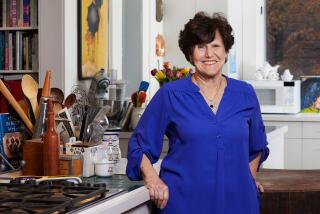Grandma’s salt cellar collection, seasoned with love

A minor mystery surrounds my grandmother’s collection of salt cellars. No one in the family seems to know when she started collecting them, or exactly how many she had.
“After somebody goes, you think of all these questions that you wished you had asked them,” my Aunt Ellen told me over the phone the other day.
My grandmother’s name was Beulah Schrag, but everyone called her Boo. She died at home in Natick, Mass., just over two years ago. At 91, she had spent 30 years without her right leg, which was amputated due to cancer the year I was born. She was a poet, an artist, a food lover and a collector of salt cellars. She had between 300 and 1,500 of the antiquated vessels for holding table salt, depending on whom in the family you ask.
The funny thing about the salts, as she called them -- I never once heard her say salt cellar -- was that although everybody knew they were her hobby and everyone was always searching for them at yard sales, in consignment shops and antique stores, nobody seems to know what they meant to her. Just that they made her happy.
“She was always delighted to get something new if it was unusual,” my grandpa Guy said. He thinks she began collecting when she was living in Arkport, N.Y., in the late 1930s and early ‘40s. She had a friend named Ruth who collected salt cellars and buttons.
One of my grandmother’s best friends, Sylvia Goodwin, agrees with Grandpa’s theory.
“Ruth sold her salts to somebody and got quite a bit of money,” she said. Sylvia and Grandma used to attend salt society meetings in Boston where they listened to lectures on salt cellars and Grandma would buy new salts. “I remember Boo and I collecting together and going to the salt society; we used to have a lot of fun going. I loved your grandmother. How I miss her.”
A living legacy
Now I am collecting too. Collecting memories -- faded, imperfect and loving -- about my grandmother’s hobby, a way she spent her time, the delicate pieces of tabletop history that pleased her. And as I hold one of them in my hand, a small pink china flower with petals for a bowl and a green stem for a base, I picture her holding it in her hand on the day she got it. She is smiling.
“She really liked the cut glass in particular,” said my Aunt Mary, who thinks Grandma started collecting in earnest in 1978, after her amputation. “She loved the way they’d glimmer when you put them on the windowsill; you know how they reflect the sunlight.”
That makes sense. Since my grandmother spent her later life on French crutches and in a wheelchair, she never took the outside world for granted. Getting out was an effort, so anything that made it come into focus for her while she sat in her yellow armchair, knitting, crafting or writing letters, was greatly appreciated.
That also explains why she liked driftwood so much. We kids would bring gnarled, sea-slicked chunks of it to her at our summer cottage in Maine because she couldn’t get down to the beach.
Grandma kept her salts in a dark wooden corner display case in the living room. It has six shelves packed with the dainty bowls, and inside the more valuable ones she placed tiny stickers on which she wrote their corresponding number and dollar value from her book on salt cellars.
Since her death the case has remained exactly as she left it. Grandpa tries his best to preserve his memories of her just as they are, and includes her in his every thought.
“Every sunset, I always say, ‘Oh Boo, that would be a great thing for you to see,’ ” he told me. And he still can’t shake the urge to look for salts whenever he finds himself at a yard sale or in a second-hand shop.
It seems nobody can. “I never go into an antique store anywhere without looking for a salt,” my mother said. “She really imparted a love for those things and wanted for us girls to have a collection.”
My mother and her two sisters all have small collections, but my mother confesses that she was more interested in finding salts to send to Grandma.
“Whenever someone has a collection, one takes great joy in finding something special for them,” she told me. “Like when you expressed an interest in turtles and suddenly all we got you were turtles, and now I’m overflowing with butterflies.”
Grandma always said that she would come back as a yellow butterfly, and the day after she died, one was fluttering around the house all day, flitting in and out of the bushes and the flowers.
Since then, when anyone buys anything for Mama, it is a butterfly.
So in that way our collections define us and speak to our history as a family. Butterflies, turtles, driftwood and salts come together to explain our impulses as guided by our hearts.
‘Remember me’
The year before she died, Grandma self-published a book of her poetry called “Don’t Fence Me In,” and in it is a poem titled “When April Comes.” The poem contains the line, “When April comes and I am not around, remember me when daffodils are found.”
Now, Grandpa is working on a poem with the line, “April came and you were not around.”
But she was, somehow. She was there in the memories left behind by her possessions -- in the glimmering bowl of a cut-glass salt left on a windowsill.
More to Read
Eat your way across L.A.
Get our weekly Tasting Notes newsletter for reviews, news and more.
You may occasionally receive promotional content from the Los Angeles Times.







